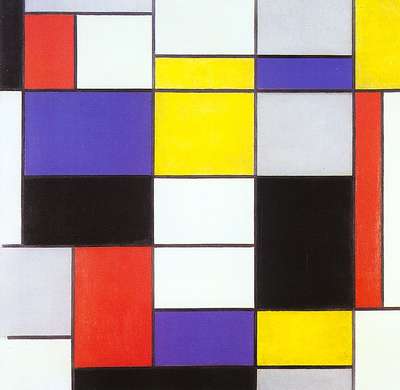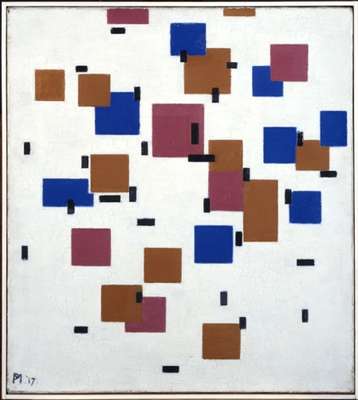Piet Mondrian was a dutch painter and one of the main figures of the Abstract art movement. Three distinct periods can be identified on his paintings, that evolved from a figurative to a non-figurative stage. Objects were gradually being reduced, until being completely independent from any visual references in the “tangible world”.
Mondrian’s journey started in a figurative approach, passing through a cubist influenced phase evolving towards a complete abstract period. However, it was his abstract paintings that acknowledged Mondrian’s work in a world wide scale.
From 1892, when Mondrian entered the Academy for Fine Arts in Amsterdam, to 1911, his paintings were mainly naturalistic and impressionistic depicting dutch landscapes. “[”Wood with Beech Trees":http://dada.compart-bremen.de/node/5403]" (1899); “[”Oostzijdse Mill with Woman":http://dada.compart-bremen.de/node/5404]" (1902); “[”The Red Cloud":http://dada.compart-bremen.de/node/5419]" (1907); “[”Seascape":http://dada.compart-bremen.de/node/5397]" (1909) are some of the pieces produced in this period.
It is known that Mondrian’s theosophical thoughts are present in his pieces as visual metaphors. Female and male representation, for instance, appear as horizontal and vertical lines. Such step in abstraction had a great impact on the way artists could deal with complex concepts or correlating them to simplified geometric compositions.
Mondrian’s canvases comprised of horizontal and vertical dark lines or planes of basic and pastel colours served as model, decades later, for numerous computer art works. Firstly, in the early history of Computer Arts we can observe Michael Noll‘s experiment that resulted in the article “[”Human or Machine:":http://dada.compart-bremen.de/node/4125] A Subjective Comparison of Piet Mondrian’s “Composition with Lines” (1917) and a Computer Generated Picture". Michael Noll was then the first computer artist to reproduce a Mondrian canvas in order to prove a concept on computer arts field. The idea was to test on how humans would prefer a computer-generated random pattern over the pattern of Mondrian’s “[”Composition with Lines":http://dada.compart-bremen.de/node/3632]".
As Michael Noll’s concludes in his article “Both patterns were conceived by humans, although certain features of the computer-generated picture were decided by a programmed random algorithm. The computer performed only as a medium performing its operations under the complete control of the computer program written by the programmer-artist.” (…) “The experiment was designed solely to compare two patterns that differed in elements of order and randomness.”
It is curious that the jury had preferred the “randomness of pattern” generated by the program over the “more-orderly” pattern painted by Mondrian.
“Mondrian often took pains to stress that his art was not the product of rational considerations, but came about intuitively: first there was practice, and only later there was theory.” A statement by the writer Carel Blotkamp in “The Art of Destruction” (1994) denies the correlation of Mondrian’s canvases with purely mathematical thoughts. However, some theories, starting from Michael Noll’s experiments, brings to discussion the fact that numbers, formulas and algorithms can be directly related to Mondrian’s compositions. Not necessarily as a generator factor but in its results and on the perception of the public.
Besides the Mondrian’s aesthetic, so often quoted in pieces of computer art, we should also consider his theoretical approach as a relevant aspect to the computer art. The abstract theory that gives the basis for Mondrian’s canvases certainly influenced the manner which the artist accept to revolutionize his methodology assuming the character of “artist-programmer”. The process of conceiving an idea, sketching it and then evolving it to the materialization of visual metaphors, introduced to the artists a new way of thinking. The moment where the artist writes the code in order to generate a result – will be a similar step of abstraction in the creative process. Mathematical metaphors are now serving as “universal language” and mediates the dialogue between the piece and the public. The piece of art, the result of the creative process, now is revealed as an output for a written code. The piece of art is not anymore the identical reflexion of the object worked by the artist. In computer art it will be the output or the direct consequence of an “algorithmic composition”. The program written itself will not have any visual similarity to the final aesthetics or plasticity of the generated object of art.
This dramatic change in the creative methodology should be associated to the abstract theory on “creating an universal language” in art and complete distance of a subject matter. When the concept of man is represented as a vertical line, for instance. The codes will equally play the role of mathematical metaphors. The final result will directly depend on this stage of pure abstraction, where equations and commands will play the role of the direct generator of the final object. In addition, the algorithm will always be a language recognizable world wide.
The medium is also a factor to reflect on. Even thou the work of the artist-programmer is the main determinant factor to the creation of the final result now the medium also plays a bigger role and sometimes a limiting condition. When developed by the artist, the code itself will never express the expected meaning by itself, the medium [the computer] was promoted to a vital medium in the production process. It might be considered limiting sometimes but the computer as a medium might be acting as an irreplaceable factor in the process as a whole.
Some examples of contemporary computer art works directly related to Mondrian’s pieces:
Mondrian
Author: Cleve Lendon
Coded in Java
javaboutique.internet.com/Mondrian
Mondrimat
http://www.stephen.com/mondrimat
Mondrian tree (interactive art)
http://www.mondriantree.com
Mondrian Tree Video














